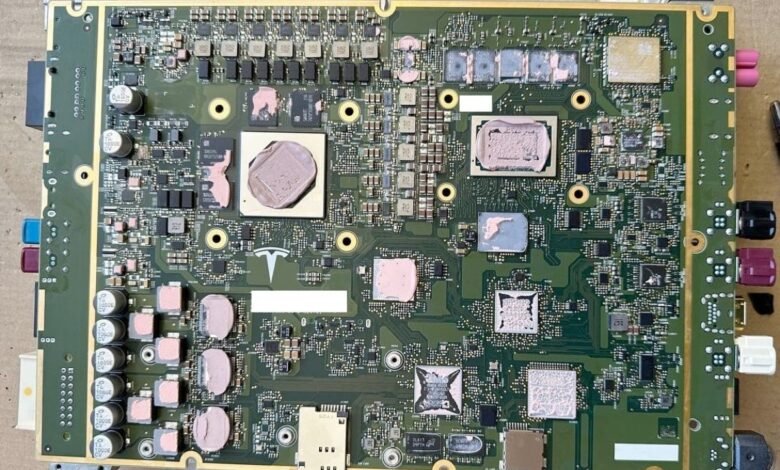Tesla’s New FSD Hardware Upgrade Revealed

▼ Summary
– Tesla has activated its first 500kW Supercharger in Redwood City, California, with the Cybertruck being the only vehicle currently capable of using this power.
– The real-world charging speed improvement for Cybertruck owners is incremental, with only about 3-4 minutes saved to reach 80% charge compared to previous Supercharger versions.
– The true advancement is the new V4 Supercharger cabinet, which has three times the power density and supports twice as many stalls, enabling faster and more cost-effective network expansion.
– Tesla may redesign its iconic door handles to comply with new Chinese safety regulations requiring mechanical releases that are easily accessible in emergencies.
– The proposed regulations aim to ensure first responders can open doors without power, potentially leading Tesla to adopt a single, safer door handle design across its vehicle lineup.
Tesla has officially launched its first operational 500kW Supercharger in Redwood City, California, marking a significant step forward for the company’s charging infrastructure. Currently, only the Cybertruck, with its advanced 800V architecture, can utilize this high-power charging capability. While the headline number is impressive, the real-world benefits for drivers appear more gradual than groundbreaking. The most transformative aspect may not be the charging speed itself, but the enhanced deployment efficiency of the new V4 Supercharger cabinets that supply the power.
For Cybertruck owners, the promise of 500kW charging suggests substantially reduced wait times compared to the previous 325kW maximum. This could be especially helpful during long trips or when towing heavy loads. According to Cybertruck lead engineer Wes Morril, the V4 charger enables the vehicle to regain up to 44% of its battery capacity in just 15 minutes, a 13% improvement over the 250kW V3 Superchargers. However, this peak charging rate is only achievable when the battery is nearly depleted. Most charging sessions begin with a higher state of charge, where the charging curve quickly flattens, narrowing the advantage of the 500kW peak. In practice, reaching 80% battery takes only about four minutes less than with a V3 Supercharger, and three minutes less than with the newer 325kW V3.5 units. While any time saved is beneficial, the improvement is incremental rather than revolutionary for current users.
The effectiveness of ultra-fast charging depends heavily on the charging curve, the ability to sustain high power over time, not just briefly hit a peak. To fully leverage 500kW charging, Tesla would need to update the Cybertruck’s battery management system and charging algorithms to maintain higher average charging rates. Without these software and hardware optimizations, the peak power remains more of a theoretical maximum than a consistent real-world benefit.
Another limitation is that, for now, this high-speed charging is exclusive to Tesla’s own Supercharger network. When connected to third-party chargers, the Cybertruck’s software caps charging power at approximately 325kW, in line with industry standards. This means that even at capable non-Tesla stations, owners won’t experience the full 500kW potential.
The real breakthrough lies in the new V4 Supercharger cabinet. Tesla’s Director of Charging, Max de Zegher, describes it as a major engineering achievement, offering three times the power density of earlier models while supporting twice as many charging stalls per unit. This leap in efficiency has far-reaching implications for network expansion. Higher power density allows more charging capacity in compact urban locations, and supporting more stalls per cabinet simplifies installation, reduces hardware expenses, and accelerates the rollout of new stations. The V4 cabinet is also designed to support future vehicles and even the Tesla Semi, with capability for up to 1.2MW charging.
In summary, while the 500kW charging speed captures attention, its immediate impact on the Cybertruck driving experience is modest. The true significance is the underlying V4 cabinet technology, which enables Tesla to build a more scalable, cost-effective, and future-ready charging network. Today’s benefit is a few minutes saved per charge, tomorrow’s could be a vastly expanded and more powerful infrastructure for all Tesla drivers.
Separately, Tesla’s distinctive flush door handles may undergo significant changes due to new safety regulations proposed in China. The Ministry of Industry and Information Technology has drafted standards requiring all vehicles to include external mechanical door handles and clearly marked interior mechanical releases. These rules aim to ensure that emergency responders can open car doors quickly, even during power failures or battery-related incidents.
Tesla’s current lineup relies entirely on electronic door handles, pop-out units on the Model S, button-activated handles on the Model X, and pivoting handles on the Model 3 and Model Y. While interior mechanical releases exist, their placement and accessibility vary. For example, earlier Model 3s lacked rear mechanical releases entirely, and newer models require removing panels or covers to access them. The proposed regulations challenge Tesla to redesign its handles to combine electronic operation with intuitive, fail-safe mechanical operation.
Tesla’s Head of Design, Franz von Holzhausen, has confirmed the company is developing new handle designs that merge electronic and manual release into a single, user-friendly mechanism. This may lead to a unified door handle design across all Tesla models, replacing the iconic but electronically dependent handles of the past. Given China’s importance as a market, Tesla is expected to adapt quickly, either by creating a region-specific design or introducing a new global standard that balances sleek aesthetics with enhanced safety and regulatory compliance.
(Source: Not a TESLA App)
